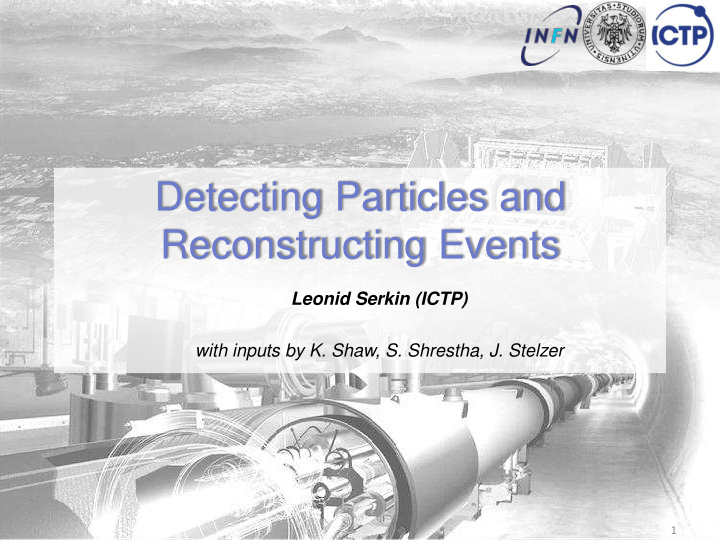



Detecting Particles and Reconstructing Events Leonid Serkin (ICTP) with inputs by K. Shaw, S. Shrestha, J. Stelzer 1
What we Learned Already Standard model: Elementary particles and forces 4 forces govern our life First family is what And the newly we are made of found Higgs to give us mass ! 2
We all Heard about Accelerators Particle beams to understand the structure of matter … starting with Rutherford in 1909 3
Production of New Particles 3 quarks form a proton : 2 u + 1 d … and a whole sea of quarks, anti -quarks and gluons – all bound by strong force Many possible interactions between the components of two colliding protons. Many ways to create particles E = mc 2 + law about conservation of energy M New Particle < E 1 + E 2 4
How we Observe Small Things Light is reflected of everything (visible) in our environment and detected by our eyes 5 mm For smaller things we invented the microscope. Higher resolution with smaller wavelength 10 um 200 nm Optical microscope Electron microscope 5
Observing Particles Can we build a super microscope ? Not really: particles too small, too fast, too many ! Different principle: look for traces of the particle when it goes through material Charged particle Charged particle through an through ionizing gas superheated fluid Scintillating material 6
Which Particles can we Detect? Particles with long lifetime Electrons, muons, protons, photons, neutrinos, kaons, pions, neutrons Can be observed Quarks hadronize into jets Can be observed Short-lived particles Particle Data Group: sorts and Can not be observed publishes all the knowledge we collect in HEP 7
Building a Detector What do we want to discover ? Which theory do we want to prove? Atomic structure (1909), structure of the proton (1967), top quark (1995), the CP violation (2001), the Higgs particle (2012) What particles can we detect? Which technologies do I have? Basic Detector designs are often similar. Always newest technologies 8
Early Detectors Bubble chambers (50’s – mid 80’s) Particles through superheated liquid produce bubbles stereo photographs Gargamelle Discovery of Ω ± Big European Bubble Chamber Important principle: charged particle tracks in a magnetic field to measure momentum and mass. Many ideas and techniques born then are still valid 9
Fixed Target Detectors Beam on fixed target detector on the other side of target SLAC Endstation A: discovery of the quark structure (1967) 10
Colliding Beam Detectors Detectors usually surround symmetrically the interaction point But not always… Physics happens in a small region Asymmetric beams 11
Measuring Momenta : Tracking Lorentz Force bends charged particles when moving through a magnetic field B p T = Bqr Determine transverse momentum ATLAS has three magnet systems Opposite charge bend in opposite direction 15
Measuring Energy : Calorimetry Calorie: old French energy unit (Latin: calor=heat) A calorimeter consists of: Dense material to fully absorb the particle Active material to produce an output signal ~ E Absorber and active materials The same homogeneous calorimeter Different sampling calorimeter Two slides, detail of showering, invasive procedure 16
ATLAS
Different Designs, same Principle Muon System (magnetic field) Hadronic Flight direction Calorimeter Electromagnetic Calorimeter Tracking (magnetic field) Different particles have different properties and leave different signatures allows the identification of particles Which stable particle is leaving no trace ? 20
Combining Information Hadrons make a Charged particles hadronic shower leave a track Collision Muons don’t interact Electromagnetically interacting particles make an much. Luckily they are electromagnetic shower charged! 26
Particle Jets from Quarks Quarks can not exist alone ! Quarks moving apart create new quark-pairs Then these quarks form hadrons flying all in one direction (a jet of Two jets observed in the ATLAS hadronic calorimeter hadrons) 27
Did we forget something ? ✔ Photons ✔ Quarks Tau, Gluons, W, Z, H Short lifetime ✔ Electrons ✔ Neutrinos ? Muons 28
How to find Neutrinos ? Neutrinos are invisible (they don’t interact) If you measure everything you can see, any imbalance you see must be from a neutrino! The total (transverse) momentum must be 0! Momentum conservation in a explosion ! Not possible to know how many neutrinos A neutrino escaped undetected ! 29
ATLAS Shockwave animation
Becoming a Particle Detective Most particles live very short. Have to deduce them from the final decay products. A D + meson decays into a K meson and a W + A p 0 meson decays into two photons 31
Becoming a Particle Detective Part II Knowledge of final decay products is not enough Higgs and p 0 both can decay into 2 photons We must also determine the original mass of the gg -system 32
Becoming a Particle Detective Part II Energy conservation + E = mc 2 momentum conservation + Higgs mass around 125 GeV 33
Another Higgs Decay – The Golden Mode Higgs 2 Z 4 leptons ATLAS H 4l with 2 years of data 34
QUESTIONS 35
Recommend
More recommend